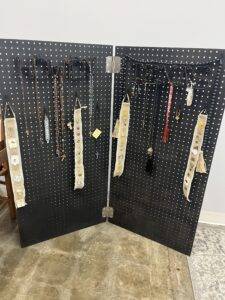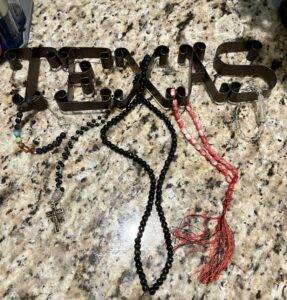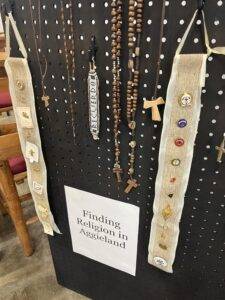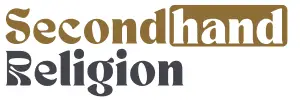Doing Religion
The Role of Devotional Objects in Faith Practices
Doing Religion features a variety of devotional objects, including Bibles, prayer beads, and meditation tools, illustrating how material objects play a role in practicing one’s faith.
This theme highlights how these devotional items serve as essential aids in spiritual rituals and personal devotion, showcasing the significance of material objects in the daily practice of faith.
ICONS
This exhibition features over 15 religious icons from four different religions. Icons are sacred images that represent prominent figures or events from a given religious tradition. They play an especially prominent role in Orthodox and Catholic Christianity, with icons regularly being used as tools in contemplative prayer. Multiple Christian icons are found in the exhibition including the Sacred Heart of Jesus, the Virgin Mary, Saint Francis, Saint Perpetua, the Virgin of Guadalupe and others.
You will also see icons from Buddhist and Hindu traditions including several renderings of the Buddha and icons with Hindu gods and goddesses such as Vishnu, Shiva, Rama & Hanuman.
These images can be paintings, wood carvings, mosaics or prints affixed to wood and gilded with gold or decorated with metal accents and are often reproductions of famous religious paintings. The creation of religious icons is a very structured practice, as they contain many ancient symbols that signify specific religious beliefs and teachings.
Iconographers, those who create icons, are trained to understand these complex visual languages and guided by specific rules of how holy figures and scenes should be painted. For example, an image of Jesus’s hand where the pointer finger is folded over the middle finger is meant to signify his knowledge of his journey to the cross.
Hindu Icons
Delve into the vibrant and intricate icons of Hindu gods such as Vishnu, Shiva, Rama, and Hanuman. These icons are rich in symbolism and are an integral part of Hindu worship.
Christian Icons
Explore the rich tradition of Christian icons, including the Sacred Heart of Jesus, the Virgin Mary, and Saint Francis. These icons are used in contemplative prayer and are adorned with gold and intricate details.
Buddhist Icons
Discover the serene and meditative icons of Buddha. These icons are often used in Buddhist practices and are created with great attention to detail and symbolism.
Prayer Beads
Prayer beads are beads strung together used to count repetitive prayers, mantras, or chants. They can be made out of glass, plastic, clay, or even precious or semi-precious stones. They may take the form of a necklace, bracelet, or be a set of beads simply carried in one’s hand or pocket. This exhibition features over a dozen sets of Catholic rosary beads, as well as prayer beads used by Buddhists, Hindus, Muslims, and other religious traditions.
The size, style and number of beads used in a strand of prayer beads differs depending on the religious tradition that uses them.

In the past decade, prayer beads have served as a model for a variety of bohemian (or boho) styled jewelry and décor items. At the very entrance to the exhibit, you will find a prayer bead garland and necklace, hanging near several examples of rosaries and actual prayer beads. These items mirror the prayer beads used by Buddhist and Hindus. However, it is likely that most people who have used or placed these as décor in their homes or as fashion accessories, likely have no idea that they have a religious connection.



Altars
An altar is a raised stand or structure used as a place of religious worship, prayer, or sacrifice. It is speculated that altars originated when people came to believe a spirit, god or goddess inhabited a place in nature such as a tree, rock or body of water, prompting people to create a place to mark and honor that spiritual being.
Altars of different types are common in public places of worship in most religious traditions, such as a communion table that sits at the front of a church, the side chapel of a Catholic church that house a saint icon, candles, and a space to pray, or a large statue of the buddha in a Buddhist temple adorned with floral and fruit sacrifices where incense is burned.
Religious individuals from many religious traditions often also create home altars on a small table, a stand, or even a shelf of a bookcase on which they place holy objects such as icons, religious symbols, spiritual readings and prayer tools.
Eight home altars have been created for this exhibition from items collected at different local thrift stores. These include Buddhist, Catholic Christian, Hindu, Jewish, New Age/Paganism, and Protestant Christian. Each has been put together based on careful study of what core items are typically found on a home altar for those of a given religious tradition and conversations with those who practice those traditions.
There is also a Day of the Dead Altar, which is a religious festival celebrated by Indigenous religion in Mexico & Central America as well as Mexican Catholics, and an important part of Hispanic culture in Texas.
The Day of the Dead, or Día de los Muertos, takes place on November 1st & 2nd and blends a variety of religions and traditions used to honor the dead including ancient Aztec customs of celebrating ancestors with Catholic’s traditions of All Souls/All Saints Day. It is believed that at this time each year deceased family relatives are allowed to return from the afterlife to visit family members for a time of celebration.
